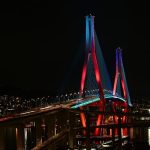Busan, South Korea – To improve the traffic flow in Busan, the Busan Metropolitan City government has announced the completion of the full tunnel breakthrough for the Mandeok~Centum Underground Expressway, part of the larger Busan Inner-City Ring Expressway project. This marks a major step in addressing traffic congestion and enhancing connectivity between key regions of the city. The milestone was celebrated with a formal event on October 15, 2024, marking the progress towards the project’s expected completion in January 2026.
The Mandeok~Centum Underground Expressway spans a total length of 9.62 kilometers, connecting Mandeok-dong in Buk-gu to Suyeonggangbyeon-daero in Haeundae-gu. The project includes three major interchanges: Mandeok IC, Central IC, and Centum IC, which will serve as key entry and exit points along the route. This expressway is being constructed deep underground at depths of 40 to 60 meters, making it the first large-scale deep-level tunnel of its kind in Busan.
The construction is being carried out by GS Construction as part of a consortium of companies under a Public-Private Partnership (PPP) framework. This partnership is funding the project with a total investment of approximately 7.8 trillion KRW, with GS Construction assuming responsibility for building and operating the expressway for a designated period.
Busan has long struggled with traffic congestion, particularly on major arterial roads such as Chungnyeol-daero, Suyeonggangbyeon-daero, and Jungang-daero. These thoroughfares experience daily gridlock, significantly slowing travel times across the city. The Mandeok~Centum Underground Expressway is expected to alleviate much of this congestion by offering an alternative, high-capacity route.
Upon completion, the new expressway will dramatically reduce travel times between Mandeok and Centum City. The current travel time of 41.8 minutes is expected to decrease to just 11.3 minutes. This reduction will not only make commuting faster and more convenient but also relieve traffic on the surface roads by increasing average travel speeds by 5-10 km/h on busy routes.
The construction of this expressway presents unique challenges due to its deep-level tunnel design. The project employs advanced tunneling methods, including vibration-controlled blasting techniques, to minimize disruption and ensure safety for nearby residents and infrastructure. The deep-level tunneling method is relatively new in urban construction in Korea, particularly in a city like Busan, where high-density urban areas require precision and careful planning.
The project’s success in overcoming these challenges is expected to provide valuable experience and insight for future infrastructure projects, especially those requiring deep-level tunneling in dense urban environments.
In addition to its impact on traffic, the Mandeok~Centum Underground Expressway is expected to yield significant economic benefits. The reduced travel times and improved traffic flow will save an estimated 648 billion KRW annually in traffic-related costs. Furthermore, the project is projected to generate approximately 12.3 trillion KRW in economic activity and create nearly 9,600 jobs.
On a broader scale, the expressway is part of Busan’s ongoing efforts to promote balanced regional development. By enhancing connectivity between the northern and eastern parts of the city, the project will contribute to the growth and development of commercial hubs like Centum City, further stimulating local economies and improving access to business and employment opportunities.
Busan’s city planners have taken steps to ensure that the Mandeok~Centum Underground Expressway adheres to stringent environmental and safety standards. The expressway will feature air purification systems strategically installed to reduce the potential for air pollution caused by vehicle emissions inside the tunnel. These systems will help maintain air quality for both tunnel users and surrounding communities.
Additionally, the project incorporates advanced safety measures, including two small fire stations and a water spray system installed every five meters throughout the tunnel to mitigate the risks of fires and other emergencies. These safety measures are designed to ensure the safety of drivers and passengers, making the expressway one of the safest underground roadways in the region.
With the successful completion of the full tunnel breakthrough, attention now turns to the final construction phases of the Mandeok~Centum Underground Expressway. Scheduled to open in January 2026, the expressway is set to become a cornerstone of Busan’s transportation infrastructure, transforming the way people travel across the city. As part of a broader urban development strategy, the expressway will not only improve traffic flow but also play a pivotal role in promoting sustainable growth and development across Busan.



